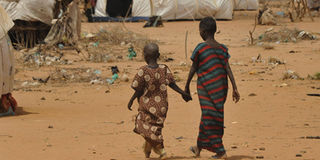Settle refugees outside: Kenya

AFP PHOTO / SIMON MAINA
Newly arrived Somali refugees walk to a registration center at the Daadab refugee camp on July 10,2011 in northeastern Kenya.
The government wants new refugees settled outside Kenya to ease congestion in existing camps.
Internal Security assistant minister Orwa Ojode said Kenya is overwhelmed by the number of people fleeing Somalia which has escalated in recent months.
“It’s a very heavy burden which we did not budget for. The United Nations Refugee Agency (UNHCR) can feed them in Somalia since the latest arrivals are not fleeing due to insecurity but lack of food,” he said.
Causing degradation
The minister said 16,398 refugees entered Kenya in June compared to 9,958 who arrived in March. Another 9,569 and 8,627 entered Kenya in April and May respectively.
The increased number, he said, was causing insecurity and environmental degradation.
The refugees at the Dadaab camp in Northern Kenya have however vowed not to go back to Somalia even if the drought ends today, rather be exposed to gunfire in Somalia.
“We have had challenges here, but at least we get constant supply of food rations and our children get medical attention.” said Mahmoud Gulled, a refugee who is in charge of about 400 families at the camp.
Rukiah Ali, 60, says drought and war make it very dangerous to live in Somalia. “Al-Shabaab would force us to donate food to them as Zakat (alms), and those who failed were killed.”
The declaration by the refugees came as a top emergency aid official of the United Nations (UN) expressed her disappointment over Kenya’s refusal to open the Ifo II camp to decongest Dadaab camps which were built to hold 90,000 refugees rather than the current 400,000. (READ: Kenya told to open up new refugee camp)
Ms Valerie Amos, the under-secretary-general for humanitarian affairs and UN’s emergency relief coordinator, said her organisation was discussing the matter with Kenya while it explores other options.
At the weekend, UNHCR chief Antonio Guterres said that the large number of people coming to Dadaab could be controlled by providing aid in Somalia.
The space in the camps here has been stretched lately as more refugees flee drought in Somalia. Those who have failed to get refugee papers are now building shanties outside the assigned areas.
The Commissioner of Refugee Affairs Badu Katelo, said that in the Dadaab region “the security situation in the camps is getting worse.”
Various organisations like the Norwegian Refugee Council and Save the Children have been trying to help the refugees.
UN Secretary-General Ban Ki-moon is expected to convene a UN meeting on Tuesday to review the world body’s response to the food and water crisis in the horn of Africa.




